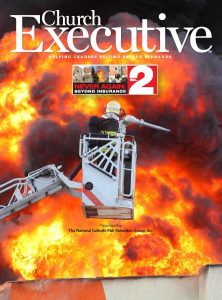
By Michael J. Bemi
 Not infrequently, pastors and their parish / congregational administrators, board and / or committee members are inclined to avail themselves of “donated” labor in the form of volunteers who purport to have the appropriate experience, expertise and equipment required to perform some necessary project work on or within parish buildings.
Not infrequently, pastors and their parish / congregational administrators, board and / or committee members are inclined to avail themselves of “donated” labor in the form of volunteers who purport to have the appropriate experience, expertise and equipment required to perform some necessary project work on or within parish buildings.
At “first blush,” such an offer of volunteered labor can appear to be an opportunity to accomplish needed maintenance, upkeep or improvements in the most cost-effective manner – usually (though not always) entailing only reimbursement for supplies and maybe equipment. What could represent better stewardship than to enhance church physical resources with a minimal outlay of the congregation’s relatively scarce financial resources? In such circumstances, the temptation to pursue this course of action is great – but the actual outcome is often negative and occasionally tragic.
It really can (and does) happen
 Some actual examples will demonstrate that “taking advantage of” volunteer labor often represents the worst – rather than the best – stewardship.
Some actual examples will demonstrate that “taking advantage of” volunteer labor often represents the worst – rather than the best – stewardship.
Consider: The church roof was leaking. Following visual inspection with binoculars, a member of the congregation with years of experience as a roofer suggested that the likely “culprit” was a portion of raised flashing, most probably damaged in a recent severe hail storm. The pastor and board were grateful for this gentleman’s offer of free labor to effect what he had described to them as a simple repair.
Sadly, in his visual inspection, he failed to note a few loose roof tiles. Upon traversing the roof to repair the flashing, these tiles separated and dropped the man to the ground. He landed on his feet, crushing his heels, ankles and lower leg bones. His medical coverage was insufficient to cover the many thousands of dollars of necessary emergency care, surgeries and rehabilitation, and he was forced to sue the parish for damages to cover these unreimbursed medical expenses.
Additionally, his ankles had to be surgically fused, which prohibited him from ever again working as a roofer – his family’s sole source of income.

Consider: A long-standing congregation member who was an HVAC (heating, ventilation and air conditioning) expert agreed to replace two air-conditioning units on the parish school’s roof. Just as in the prior example, the pastor and board were grateful and relieved that they would only have to pay for the air-conditioning units and not for any work.
The expert brought his less-experienced assistant along on a weekend to accomplish this task. Note that the assistant was not going to receive any compensation; he was simply going to be able to “take advantage” of a new work experience, outside of the stress of a normal workday.
The assistant improperly secured some critical rigging, causing one of the units to fall from a scaffold onto the head of the expert below. After weeks in a coma and months of treatment and rehabilitation, it was clear that this poor man would never again be the same. Litigation against the parish continues to this day.
Look beyond the surface appeal
Often, donated labor produces a less than truly satisfactory result, while also exposing the congregation to extensive costs never contemplated.
Even worse, the pastor, board and congregation must live with the guilt of being associated with irreversible tragedies of pain and suffering like those recounted here.
Before engaging volunteers in any activity that entails significant physical labor, the use of potentially dangerous tools and / or the existence of perilous working conditions (examples: activity above ground or floor level; involving lifting of heavy weighted objects; involving heavy machinery; using hazardous compounds or substances; working with electricity), the congregation is very well served to “shop around” for the best-priced proposal from a professional firm that has a great reputation, skilled staff, proper equipment, appropriate licenses / permits, professional certifications, high-quality insurance and a contract with terms that protect the congregation.
This is the best stewardship.
Michael J. Bemi is president & CEO of The National Catholic Risk Retention Group, Inc. (Lisle, IL) — a recognized leader in risk management. To learn more about available coverage — and to get valuable tools, facts and statistics — visit www.tncrrg.org.


